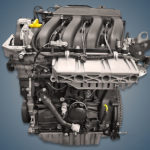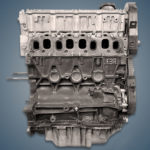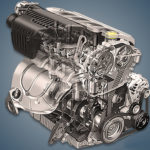The 2.0-liter Renault F5R or 2.0 idE engine was assembled at the concern’s factory from 1999 to 2003 and was installed only on the first generation Megane coupe, as well as on the Laguna 2 before restyling. This unit is distinguished by the presence of a direct fuel injection system from Siemens.
The F-series include: F3P, F4P, F7P, F2R, F3R, F4R, F4Rt, F5R, F7R.
In 1999, the Megane Coupe debuted a 2.0-liter unit with direct fuel injection. By design, this engine repeated the engine already popular at that time under the F4R index: it has a cast-iron cylinder block and an aluminum 16-valve head with hydraulic compensators, a timing belt drive, an ignition system with a pair of dual coils from Sagem and an EGR valve. A feature of the engine was the innovative Siemens direct fuel injection system.
This engine turned out to be so capricious that its production was quickly abandoned and Renault dared to return to the idea of such engines only after almost ten years.
The engine was installed on:
- Renault Megane 1 (X64) in 1999 – 2001;
- Renault Laguna 2 (X74) in 2001 – 2003.
Specifications
| Production years | 1999-2003 |
| Displacement, cc | 1998 |
| Fuel system | direct injection |
| Power output, hp | 140 |
| Torque output, Nm | 200 |
| Cylinder block | cast iron R4 |
| Block head | aluminum 16v |
| Cylinder bore, mm | 82.7 |
| Piston stroke, mm | 93 |
| Compression ratio | 10.0 |
| Hydraulic lifters | yes |
| Timing drive | belt |
| Turbocharging | no |
| Recommended engine oil | 5W-30, 5W-40 |
| Engine oil capacity, liter | 6.0 |
| Fuel type | petrol |
| Euro standards | EURO 3 |
| Fuel consumption, L/100 km (for Renault Laguna 2002) — city — highway — combined |
10.7 6.2 7.8 |
| Engine lifespan, km | ~300 000 |
| Weight, kg | 145 |
Disadvantages of the Renault F5R engine
- All the main problems of the engine are somehow connected with the vagaries of the fuel system: the pressure regulator fails, the injection pump wears out and the filter in the line clogs. Also, sometimes the cause is a drop in the performance of the booster pump.
- Another weak point of this motor is not a very reliable ignition system. Sagem twin coils and their high-voltage wires are distinguished by a low resource, candles go relatively little, and the manufacturer recommends expensive iridium ones.
- After 150,000 km, car owners with such a unit often encounter an oil burner and the culprits are usually stuck oil scraper rings or worn caps. However, if you use high-quality oil, then consumption appears much later.
- A lot of trouble for the owners is delivered by the ever-sticking EGR valve with an electric drive. Lubrication leaks are also common here, and the valves are also bent when the timing belt breaks.






